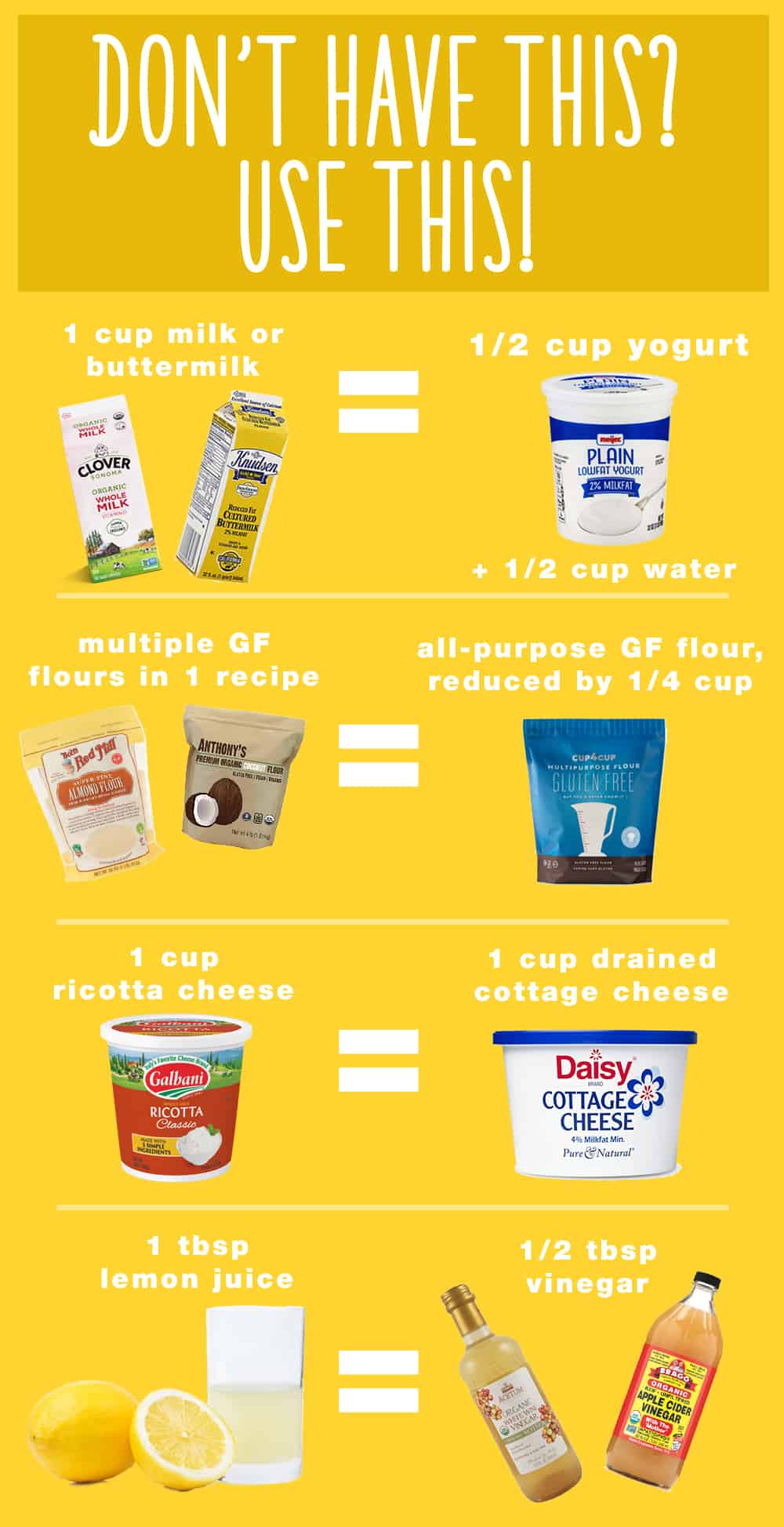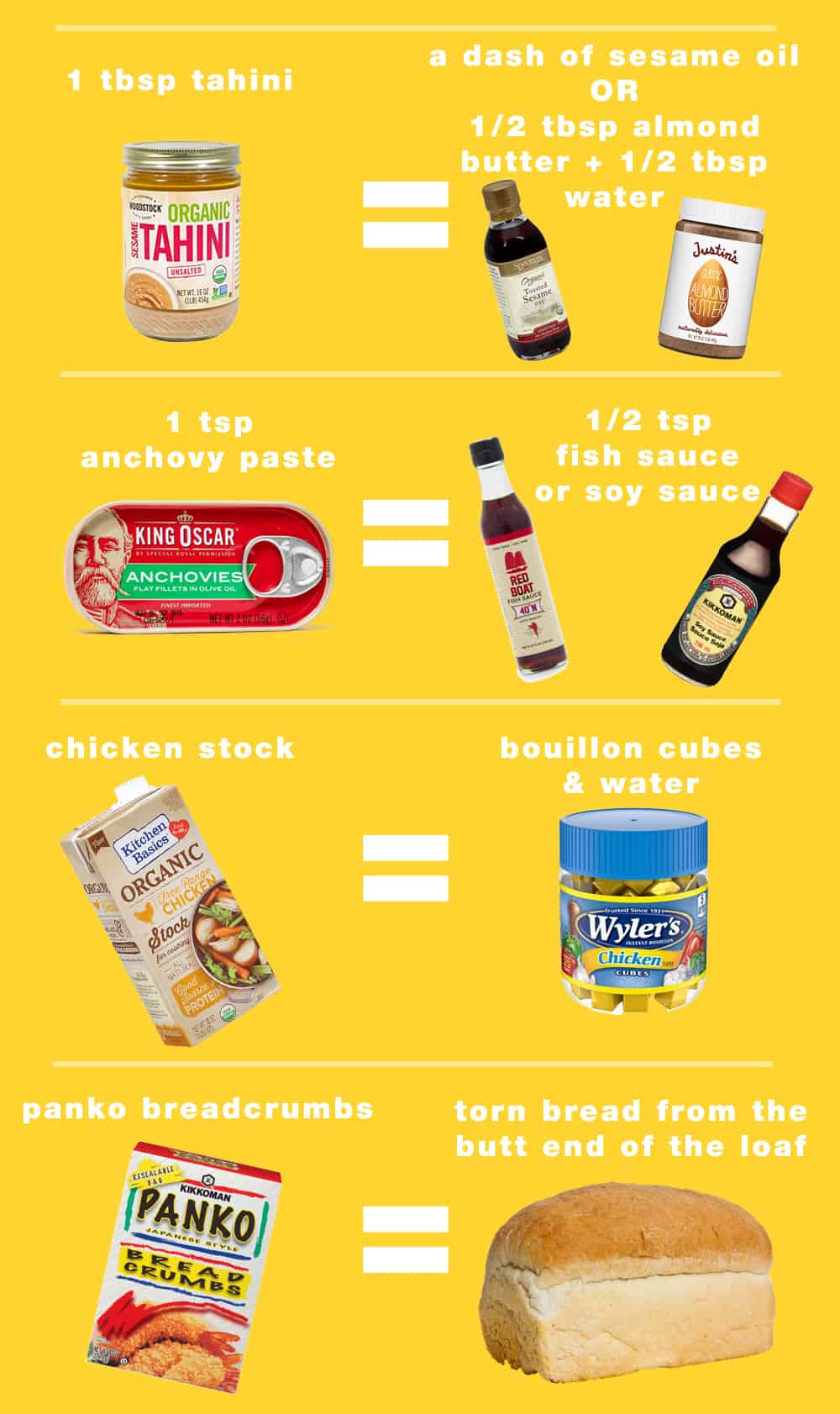Out of milk? Need more breadcrumbs? Behold, our guide to the most common recipe substitutions!
We are all in this together, right? Right. We need to make multiple meals a day with what is readily available and what we have on hand in our home kitchens- and sometimes that means we don't have everything we need for a recipe. Substitutions are nothing to be afraid of! It’s simply a time to really think about what you are doing and taste what you are making. Actually, practicing this will inevitably make you a stronger cook in the long run.
Below are a few suggestions for when you don’t have a particular ingredient. I should mention that this is not a guarantee for everything. Depending on the recipe you may have to adjust the quantity of something to get the same effect, but don’t dismay. This is the time to follow your gut. When making a substitute, you really need to think about a recipe- and my trick, start with less and then add more if you need it. Smell, taste and touch to figure out if that works for you and what you are going for. Don’t be afraid. I have faith in you and know you can do it. And to that point, if you have questions on what you could sub in for any particular ingredient, ask us about it in the comments. Team Giadzy is always here for support!
Milk or Buttermilk
1 cup milk or buttermilk = 1/2 cup yogurt + 1/2 cup water
I would suggest starting with 1/2 cup yogurt + 1/2 cup water. That will probably give you a pretty accurate consistency.
Gluten-Free Flours
multiple GF flours in 1 recipe = 3/4 cup all-purpose gluten free flour
If a recipe calls for 2 or 3 gluten free flours in a recipe, that typically is the recipe writers’ way of making their own blend. Usually, an all-purpose blend can work instead. Just be aware that the blend might absorb differently than the specific flours, so we suggest reducing the amount of all purpose flour being used by 1/4 cup per recipe.
Ricotta Cheese
1 cup ricotta cheese = 1 cup drained cottage cheese
This isn’t going to be exactly the same in texture but you will still get a lovely creamy mouth feel plus a little added bonus of a cheese pull from cottage cheese. Just be sure to drain in a fine mesh strainer first so it doesn’t leach out too much liquid into your dish. A coffee filter or clean towel in a colander would work just as well.
Lemon Juice
1 Tbsp lemon juice = 1/2 Tbsp white wine vinegar or apple cider vinegar
This will work in most cases as an even swap. None the less, I find lemon to be a bit less assertive so I would start with 1/2 the amount when using vinegar in this substitution and taste as you go along. Remember you can always add more but you can’t take away once it’s all in.
Tahini
1 Tbsp tahini = a dash of toasted sesame oil or 1/2 Tbsp almond butter + 1/2 Tbsp water
As mentioned above, just start small with this one. The taste of sesame oil is much more intense than tahini. And if you are using the almond butter, thin the almond butter on a 1 to 1 ratio.
Anchovy Paste
1 tsp anchovy paste = 1/2 tsp fish sauce or soy sauce
If a recipe calls for anchovies or anchovy paste, chances are a dash of fish sauce could do the trick. Start with 1/2 the amount called for in the recipe. If fish sauce is not something you typically find in your refrigerator door, try a dash of soy sauce. Again, start with half the amount. You can always add more. It will lend that same depth of flavor that its fishy counterparts do.
Chicken Stock
chicken stock = bouillon cube and water
Remember that jar of ‘just in case’ bouillon cubes you have stashed in the back of the cabinet? Well this is the time to use them. Follow the directions on the jar and a splash more water. Bouillon tends to be saltier than prepared broth so diluting it a touch more should do the trick.
Breadcrumbs
panko breadcrumbs = hand torn bread from the butt end of the loaf
This may seem tedious but it’s a great way to get the kids involved too…or significant others who don’t like to help out in the kitchen. It means literally tearing little pinch size pieces of bread off of whatever old loaf you have then drying them slightly in the oven. What you are left with might be even lighter and crunchier than panko. Takes some time but also saves that stale bread you would have thrown out.
These might go without saying, but are worth mentioning:
Beans
canned bean = canned bean
Have chickpeas but not white beans? Or vice versa? No problem at all. Same holds true for pinto beans or even kidney or black beans (though the color could be off putting if using in a puree). Bottom line, for soups, stews and sautés, I don’t really see this substitute as being a problem.
Nut Butter
nut butter = nut butter
If a recipe calls for almond butter and all you have is peanut butter, as long as you like peanut butter and it works with the other flavors in the recipe, go for it. Same holds true for cashew butter or even sunflower seed butter. Just take note of the sugar content. If you are using a sweetened butter you may want to reduce the amount of sugar in a recipe or use less of the nut butter if it’s a savory dish.




















0 comments